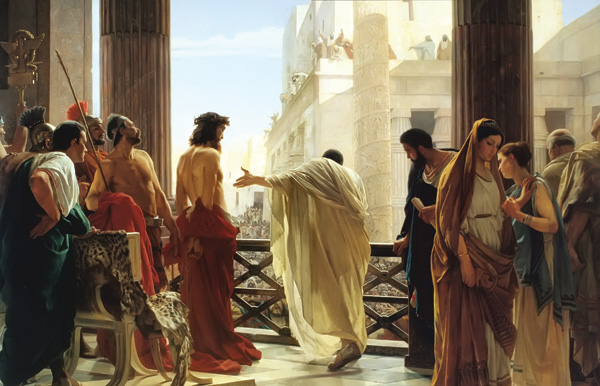 The judge is short and patrician, with darting eyes and expensive clothes, greying hair trimmed and face beardless. He is apprehensive, nervous about being thrust into a decision he can't avoid. Two soldiers lead him down the stone stairs of the fortress into the broad courtyard. Shafts of morning sunlight stretch across the stone floor.
The judge is short and patrician, with darting eyes and expensive clothes, greying hair trimmed and face beardless. He is apprehensive, nervous about being thrust into a decision he can't avoid. Two soldiers lead him down the stone stairs of the fortress into the broad courtyard. Shafts of morning sunlight stretch across the stone floor.
As he enters, Syrian soldiers dressed in short togas yank themselves and their spears erect and stare straight ahead. The floor on which they stand is a mosaic of broad, brown, smooth rocks. On the floor are carved the games the soldiers play while awaiting the sentencing of the prisoner.
But in the presence of the procurator, they don't play.
A regal chair is placed on a landing five steps up from the floor. The magistrate ascends and takes his seat. The accused is brought into the room and placed below him. A covey of robed religious leaders follow, walk over to one side of the room and stand.
Pilate looks at the lone figure.
“Are you the king of the Jews?”
For the first time, Jesus lifts His eyes. He doesn't raise His head, but He lifts His eyes. He peers at the procurator from beneath His brow. Pilate is surprised at the tone in Jesus' voice.
“Those are your words.”
Before Pilate can respond, the knot of Jewish leaders mock the accused from the side of the courtroom.
He's not angry with me. He's not afraid. He seems to understand.
Pilate is correct in his observation. Jesus is not afraid. He is not angry. He is not on the verge of panic. For He is not surprised. Jesus knows His hour and the hour has come.
Pilate is correct in his curiosity. Where, if Jesus is a leader, are His followers? What, if He is the Messiah, does He intend to do? Why, if He is a teacher, are the religious leaders so angry at Him?
Pilate is also correct in his question. “What shall I do, then, with Jesus who is called the Messiah?” (See Matthew 27:22.)
Accept or Reject
Perhaps you, like Pilate, are curious about this One called Jesus. You, like Pilate, are puzzled by His claims and stirred by His passions. What do you do with a man who calls Himself the Saviour, yet condemns systems? What do you do with a man who knows the place and time of His death, yet goes there anyway?
Pilate's question is yours. “What will I do with this man, Jesus?”
You have two choices.
You can reject Him. That is an option. You can, as have many, decide that the idea of God's becoming a carpenter is too bizarre—and walk away.
Or you can accept Him. You can journey with Him. You can listen for His voice amid the hundreds of voices and follow Him.
Illustration: Ecce Homo (Here is the Man) by Antonio Ciseri (1821-91). The title of the painting refers to the Latin words used by Pontius Pilate when he presented Jesus to the hostile crowd shortly before His Crucifixion (see John 19:5)









Leave a Comment